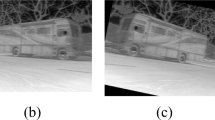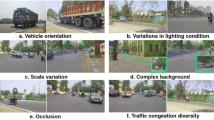Abstract
Due to static traffic management regulations on roadways, traffic flow may become congested as it has been growing on roads. Estimating traffic density impacts intelligent transportation systems as it helps build efficient traffic management. Vehicle recognition and counting are two main steps to estimate traffic density. Vehicle identification systems can use motion, handcrafted features, and convolutional neural network (CNN)-based methods. The utilization of deep learning technologies is increasing daily with the popularity of CNN. Different classification and detection models have been developed using transfer learning. In this study, data are collected from several open-source libraries, including MB7500, KITTI, and FLIR. Image annotation has been done to classify vehicles into different categories. Various data augmentation methods are implemented to increase the dataset size and to reduce class imbalance problem. Image quality has been enhanced by performing the sharpening process. Then, a hybrid model of Faster R-CNN and YOLO using majority voting classifier has been trained on processed data. The proposed model’s findings have been compared with its base estimators on the collected datasets. The proposed model has demonstrated detection accuracy of up to 98%, whereas YOLO and Faster R-CNN provide 95.8 and 97.5%, respectively. Additionally, compared to YOLO and Faster R-CNN, experimental results show that the proposed model performs better at estimating traffic density. Hence, the proposed approach can effectively enhance road traffic management.


























Similar content being viewed by others
Explore related subjects
Discover the latest articles, news and stories from top researchers in related subjects.Data Availability
Data sharing not applicable to this article as no datasets were generated or analyzed during the current study.
References
He K, Zhang X, Ren S, Sun J (2014) Spatial pyramid pooling in deep convolutional networks for visual recognition. In: ECCV
Girshick R, Donahue J, Darrell T, Malik J (2014) Rich feature hierarchies for accurate object detection and semantic segmentation. In: CVPR
He K, Zhang X, Ren S, Sun J (2016) Deep residual learning for image recognition. In: CVPR
Mittal U, Srivastava S, Chawla P (2019) Review of different techniques for object detection using deep learning. In: Proceedings of the third international conference on advanced informatics for computing research - ICAICR ’19, pp. 1–8, https://doi.org/10.1145/3339311.3339357
Dalal N, Triggs B (2005) Histograms of oriented gradients for human detection. In: CVPR
Lowe DG (1999) Object recognition from local scale-invariant features. In: ICCV
Lienhart R, Maydt J (2002) An extended set of haar-like features for rapid object detection. In: International conference on image processing
Fidler S, Mottaghi R, Yuille A, Urtasun R (2013) Bottom-up segmentation for top-down detection. In: CVPR
Kleban J, Xie X, Ma W-Y (2008) Spatial pyramid mining for logo detection in natural scenes. In: Multimedia and Expo, 2008 IEEE international conference on
Girshick R (2015) Fast r-cnn, In: ICCV
Uijlings JR, Van De Sande KE, Gevers T, Smeulders AW (2013) Selective search for object recognition. In: IJCV
Ren S, He K, Girshick R, Sun J (2015) Faster r-cnn: Towards real-time object detection with region proposal networks. In: NeurIPS
Dai J, Li Y, He K, Sun J (2016) R-fcn: Object detection via region-based fully convolutional networks. In: NeurIPS
Lin T-Y, Doll´ar P, Girshick R, He K, Hariharan B, Belongie S (2017) Feature pyramid networks for object detection. In: CVPR
Redmon J, Divvala S, Girshick R, Farhadi A (2016) You only look once: Unified, real-time object detection. In: CVPR
Liu W, Anguelov D, Erhan D, Szegedy C, Reed S, Fu C-Y, Berg A C (2016) SSD: Single shot multibox detector, In: ECCV
Redmon J, Farhadi A (2017) Yolo9000: better, faster, stronger. In: CVPR
Lin T-Y, Goyal P, Girshick R, He K, Doll´ar P (2017) Focal loss for dense object detection. In: ICCV
Law H, Deng J (2018) Cornernet: Detecting objects as paired keypoints. In: ECCV
Zhang Z, Xu C, Feng W (2017) Road vehicle detection and classification based on Deep Neural Network. In: Proceedings of the 7th IEEE international conference on software engineering and service science, Aug. 26–28, IEEE Xplore Press: Beijing, China, pp. 675–678. https://doi.org/10.1109/ICSESS.2016.7883158
Harsha SS, Anne KR (2016) Gaussian mixture model and deep neural Network based Vehicle Detection and Classification. (IJACSA) Int J Adv Comput Sci Appli, Vol. 7(9): pp. 17–25
Zhou Y, Nejati H, Do T T, Cheung NM, Cheah L (2016) Image-based Vehicle Analysis using Deep Neural Network: A Systematic Study. In: IEEE international conference on digital signal processing (DSP). Beijing, China: IEEE
Gao Y, Lee HJ (2015) Moving car detection and model recognition based on deep learning. Adv Sci Technol Lett, pp. 57–61
Chan YM, Huang SS, Fu LC, Hsiao PY, Lo MF (2012) Vehicle detection and tracking under various lighting. IET Intell Trans Sys 6:1–8
Berg A, Ahlberg J, Felsberg M (2015) A thermal object tracking benchmark. In: 12th IEEE international conference on advanced video and signal based surveillance (AVSS) (pp. 1–7). Karlsruhe, Germany: IEEE
Mittal U, Srivastava S, Chawla P (2019) Object detection and classification from thermal images using region based convolutional neural network. J Comput Sci 15(7):961–971. https://doi.org/10.3844/jcssp.2019.961.971
Rodin CD, Lima LN, Andrade FA, Haddad DB, Johansen TA, Storvold R (2018) Object classification in thermal images using convolutional neural networks for search and rescue missions with unmanned aerial systems. Int Joint Conf Neural Netw (IJCNN) 2018:1–8
Nam Y, Nam Y-C (2018) Vehicle classification based on images from visible light and thermal cameras. EURASIP J Image Video Process. https://doi.org/10.1186/s13640-018-0245-2
Moranduzzo T, Melgani F (2014) Detecting cars in UAV images with a catalog-based approach. IEEE Trans Geosci Remote Sens 52(10):6356–6367
Chen Y-L, Chen T-S, Huang T-W, Yin L-C, Wang S-Y, Chiueh T-C (2013) Intelligent Urban video surveillance system for automatic vehicle detection and tracking in clouds. In: IEEE 27th international conference on advanced information networking and applications (AINA) (pp. 814–821). Barcelona, Spain: IEEE
Tuermer S, Kurz F, Reinartz P, Stilla U (2013) Airborne vehicle detection in dense Urban areas using HoG features and disparity maps. IEEE J Selected Topics Appl Earth Observ Remote Sens 6(6):2327–2337. https://doi.org/10.1109/JSTARS.2013.2242846
Prabha C, Shah I (2016) Study of vehicular traffic using hybrid deep neural network. Int J Innov Res Comput Commun Eng pp. 4334–4338.
Chen Z, Ellis T, Velastin SA (2012). Vehicle detection, tracking and classification in Urban Traffic. In: 15th international IEEE conference on intelligent transportation systems (pp. 951–956). Anchorage, Alaska, USA,: IEEE
He D, Lang C, Feng S, Du X, Zhang C (2015). Vehicle detection and classification based on convolutional neural network. In: Proceedings of the 7th international conference on internet multimedia computing and service, (pp. 1–5). Zhangjiajie, Hunan, China
Chen Z, Ellis T, Velastin SA (2011) Vehicle type categorization: a comparison of classification schemes. In: Proceedings of the 14th international IEEE conference on intelligent transportation systems washington, DC, USA, pp: 74–79. https://doi.org/10.1109/ITSC.2011.6083075
Vijayaraghavan V, Laavanya M (2019) Vehicle classification and detection using deep learning. Int J Eng Adv Technol (IJEAT) 9(15):24–28
Ma R, Zhang Z, Dong Y, Pan Y (2020) deep learning based vehicle detection and classification methodology using strain sensors under bridge deck. Sensors 20(18):5051. https://doi.org/10.3390/s20185051
Krizhevsky A, Sutskever I, Hinton GE (2012) Imagenet classification with deep convolutional neural networks. In: NeurIPS
Szegedy C, Liu W, Jia Y, Sermanet P, Reed S, Anguelov D, Erhan D, Vanhoucke V, Rabinovich A (2015) Going deeper with convolutions. In: CVPR
Simonyan K, Zisserman A (2014) Very deep convolutional networks for large-scale image recognition. In: arXiv preprint arXiv:1409.1556
He K, Zhang X, Ren S, Sun J (2016) Identity mappings in deep residual networks. In: ECCV, Springer
Newell A, Yang K, Deng J (2016) Stacked hourglass networks for human pose estimation. In: ECCV
Huang G, Liu Z, Van Der Maaten L, Weinberger KQ (2017) Densely connected convolutional networks. In: CVPR, 2017
Chen Y, Li J, Xiao H, Jin X, Yan S, Feng J (2017) Dual path networks. In: NeurIPS, 2017, pp. 4467–4475
Howard AG, Zhu M, Chen B, Kalenichenko D, Wang W, Weyand T, Andreetto M, Adam H (2017) Mobilenets: efficient convolutional neural networks for mobile vision applications, in: arXiv preprint arXiv:1704.04861
Cai Z, Vasconcelos N (2018) Cascade r-cnn: Delving into high quality object detection. In: CVPR
Duan K, Bai S, Xie L, Qi H, Huang Q, Tian Q (2019) Centernet: Keypoint triplets for object detection, in: arXiv preprint arXiv:1904.08189
Maithani M (2020). EfficientDet: Guide to state of the art object detection model. Retrieved from https://analyticsindiamag.com/efficientdet/
Kaur R, Talwar M, (2016) Automated vehicle detection and classification with probabilistic neural network. IJARIIT
Bhartee AK, Srivastava KM, Sharma T (2017) Object Identification using thermal image processing. Int. J. Eng. Sci. Computing
Mittal U, Potnuru R, Chawla P (2020) Vehicle detection and classification using improved faster region based convolution neural network. In: 2020 8th International conference on reliability, infocom technologies and optimization (Trends and Future Directions) (ICRITO), 2020, pp. 511–514, https://doi.org/10.1109/ICRITO48877.2020.9197805
Oliveira DC, Wehrmeister MA (2018) Using deep learning and low cost RGB and thermal cameras to detect pedestrians in aerial images captured by multirotor UAV. Sensors (Basel) 18(7):2244. https://doi.org/10.3390/s18072244
Sun W, Zhang G, Zhang X, Zhang X, Ge N (2020) Fine-grained vehicle type classification using lightweight convolutional neural network with feature optimization and joint learning strategy. Multimed Tools Appl 80(20):30803–30816. https://doi.org/10.1007/s11042-020-09171-3
Ranjeeth Kumar C, Anuradha R (2020) RETRACTED ARTICLE: Feature selection and classification methods for vehicle tracking and detection. J Ambient Intell Human Comput 12(3):4269–4279. https://doi.org/10.1007/s12652-020-01824-3
Wang X, Chen X, Wang Y (2020) Small vehicle classification in the wild using generative adversarial network. Neural Comput Appl 33:5369–5379. https://doi.org/10.1007/s00521-020-05331-6
Shvai N, Hasnat A, Meicler A, Nakib A (2020) Accurate classification for automatic vehicle-type recognition based on ensemble classifiers. IEEE Trans Intell Transp Syst 21(3):1288–1297. https://doi.org/10.1109/tits.2019.2906821
Awang S, Azmi NMAN, Rahman MdA (2020) Vehicle type classification using an enhanced sparse-filtered convolutional neural network with layer-skipping strategy. IEEE Access 8:14265–14277. https://doi.org/10.1109/access.2019.2963486
Grents A, Varkentin V, Goryaev N (2020) Determining vehicle speed based on video using convolutional neural network. Transportation Research Procedia 50:192–200. https://doi.org/10.1016/j.trpro.2020.10.024
Zhu J, Li X, Jin P, Xu Q, Sun Z, Song X (2020) MME-YOLO: Multi-sensor multi-level enhanced YOLO for robust vehicle detection in traffic surveillance. Sensors 21(1):27. https://doi.org/10.3390/s21010027
Jagannathan P, Rajkumar S, Frnda J, Divakarachari PS (2021) Moving vehicle detection and classification using gaussian mixture model and ensemble deep learning technique. Wireless Commun Mobile Comput 2021:1–15. https://doi.org/10.1155/2021/5590894
Hu X, Wei Z, Zhou W, (2021) A video streaming vehicle detection algorithm based on YOLOv4. In: 5th advanced information technology, electronic and automation control conference (IAEAC), pp. 2081–2086, https://doi.org/10.1109/IAEAC50856.2021.9390613.
Yang Y et al (2021) A fast and effective video vehicle detection method leveraging feature fusion and proposal temporal link. J Real-Time Image Proc 18(4):1261–1274. https://doi.org/10.1007/s11554-021-01121-y
Sri Jamiya S, Esther Rani P (2021) LittleYOLO-SPP: A delicate real-time vehicle detection algorithm. Optik 225:165818. https://doi.org/10.1016/j.ijleo.2020.165818
Wang X (2022) Vehicle image detection method using deep learning in UAV video. Comput Intell Neurosci 2022:1–10. https://doi.org/10.1155/2022/8202535
Funding
No funding support for this work.
Author information
Authors and Affiliations
Corresponding author
Ethics declarations
Conflicts of interest
We declare no any conflict of interest. This manuscript is submitted only in this journal and is not in parallel submitted or in review at any other venue.
Additional information
Publisher's Note
Springer Nature remains neutral with regard to jurisdictional claims in published maps and institutional affiliations.
Rights and permissions
Springer Nature or its licensor (e.g. a society or other partner) holds exclusive rights to this article under a publishing agreement with the author(s) or other rightsholder(s); author self-archiving of the accepted manuscript version of this article is solely governed by the terms of such publishing agreement and applicable law.
About this article
Cite this article
Mittal, U., Chawla, P. & Tiwari, R. EnsembleNet: a hybrid approach for vehicle detection and estimation of traffic density based on faster R-CNN and YOLO models. Neural Comput & Applic 35, 4755–4774 (2023). https://doi.org/10.1007/s00521-022-07940-9
Received:
Accepted:
Published:
Issue Date:
DOI: https://doi.org/10.1007/s00521-022-07940-9




